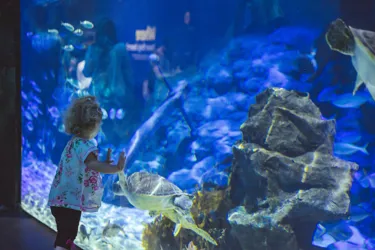Animal in Focus: Turtles
- Friday 13th December 2024

They’re not slow, and they’re not shy! Turtles are fascinating, and the more we learn about our flippered friends, the better. For a start, don’t confuse them with their land-bound cousins, the tortoise. Sea Turtles can be fast, paddling at speed through the water. Remember the scene from Finding Nemo, where the turtles zoom through the ocean? Most of our New Zealand Sea Turtles are capable of speed, but for the most part, they’re happy cruising around, looking for lunch.
Love turtles? Find out more about world turtle day here!
Whos Who?
Green Turtle

Found: Rangaunu Harbour and Poor Knights Islands
The green sea turtle is a true ocean voyager. With their beautiful, smooth shells and powerful flippers, these turtles travel thousands of miles across the Pacific. In New Zealand waters, they often grace our northern beaches, enjoying the warm currents.
Fun Fact! Green sea turtles can travel thousands of miles between their feeding grounds and nesting sites.
Hawksbill Turtle
Found: Tropical islands (rare)
With their large heads and powerful jaws, loggerhead turtles are the crushers of the sea, feeding on hard-shelled prey like crabs and mollusks.. Their impressive migrations can bring them close to our shores, where they come to nest and bask in the sun, they love the warm and tropical waters
Fun Fact! While sponges make up a significant part of their diet, Hawksbills also eat anemones, jellyfish, and other invertebrates. Their varied diet helps maintain a balanced reef ecosystem.
Leatherback Turtle

Found: North Cape, and Northland, on the Eastern side
Leatherbacks are the largest sea turtles, with a unique, leathery shell instead of a hard one. They can dive deeper than any other turtle species and feed mainly on jellyfish. Leatherback Turtles are common locally but critically endangered globally.
Fun Fact! They can dive to depths of over 3,000 feet, deeper than any other turtle species, and can stay underwater for up to 85 minutes.
Loggerhead Turtle
Found: Upper North Island
Loggerheads only visit from time to time, with their large heads and powerful jaws, loggerhead turtles are the crushers of the sea. These mighty turtles can be spotted in the subtropical waters around New Zealand. Their impressive migrations can bring them close to our shores, where they come to nest and bask in the sun.
Fun Fact! Loggerheads have powerful jaws that allow them to crush hard-shelled prey like crabs and clams.
Olive Ridley Turtle

Found: Northern waters (rare)
Olive Ridley Turtles are scarce locally but look like Green Turtles, with more olive colour. The funny name was bestowed by fishermen, who considered these turtles to be an unusual ‘riddle.’
Fun Fact! After hatching, baby Olive Ridleys make an incredible journey to the ocean, guided by the natural light reflecting off the water. This journey is fraught with danger, with many hatchlings falling prey to predators.
Find out the role these wonderful creatures play in our oceans and learn some more fun facts here!
Turtle Tucker
Sea Turtles eat anything from molluscs and anemones to seagrass and sponges! Some have adapted narrow jaws to fish out tasty morsels from crevices in coral and rock. Others can grind through the tough exteriors of shellfish and shrimp. A Sea Turtle’s diet can also change throughout its lifespan. Unfortunately, they often snack on plastic, mistaking it for food. Shopping bags, in particular, can look like tasty jellyfish. The Department of Conservation (DOC) often gets called to rescue stranded or injured turtles, bringing them to SEA LIFE Kelly Tarlton’s Aquarium for rehabilitation. We work closely with the New Zealand Centre for Conservation Medicine to give these turtles the best chance of survival. SEA LIFE Kelly Tarlton's is the only place in New Zealand that rehabilitates turtles, so we’re an essential link in the marine wellness chain!
If you would like to check out our Turtle Rehabilitation Centre click here!
Take a Turtle Journey!
See first-hand how we work with turtles in our all-new Turtle Bay interactive zone! We want to share the experience with you, so you become part of the turtle’s journey back to the ocean. By encouraging understanding, we hope you’ll form a connection with these fantastic animals and care about their future! We are so lucky to have 5 kinds of Sea Turtle in New Zealand, so we want to preserve their presence, despite threats to their environment. That’s why our Turtle Rehab program is such a positive experience for visitors and our dedicated staff.
Check out our turtle bay and turtle release page here!
Sea Turtles are protected under the Wildlife Act 1953. If you ever find one stranded the best thing to do is call the DOC on 0800 DOC HOT or SEA LIFE Kelly Tarlton’s Aquarium. We’ll tell you what to do next! And if you’d like to experience a rescued turtle’s journey, come and visit us soon in Turtle Bay!
You can book here!

